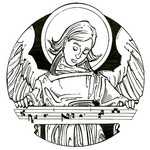Each year at the Colloquium, we offer a Requiem Mass for the deceased members of the CMAA. Since the Motu Proprio, “Summorum Pontificum” in 2007, we have had the option of offering the Mass in the Extraordinary Form of the Roman Liturgy as well. This year we will celebrate a Solemn Requiem Mass with Absolution at the Catafalque. This practice was prescribed for All Souls Day as well as any Solemn Mass for the dead where the body was not present. This practice could be somewhat unsettling if one is not used to it, or doesn’t understand it.
Our faith, heavily permeated by the theology of the Incarnation, uses things to convey spiritual realities. The highest realities, of Divine institution, are the Sacraments. The greatest sacrament is of course the Holy Eucharist, where the elements of bread and wine are changed into the Body and Blood of our Lord. Sacramentals, or blessed objects, are used to dispose us to the many graces that come from God. Finally, symbols, art, music and architecture lift the mind and the heart to God.
The catafalque is either an empty casket or a wooden form made to look like a casket that is covered by the black pall and surrounded by six unbleached (orange) candles (when they are available); it is a symbolic representation of the deceased. When it is present, the priest sings the absolution for the deceased as if the body was present. The body was the Temple of the Holy Spirit and must be shown the greatest respect, even symbolically.
The use of the catafalque also calls to mind the stark reality of death and judgment, but in contrast, the hope of God’s mercy and redemption. We offer the absolution for the dead and we pray that we will be prepared for death. We realistically and vividly face the reality of death and just as realistically and vividly we profess our belief in the Resurrection. Our faith is strong―even stronger―by meditating upon the death we know will come to all of us.

